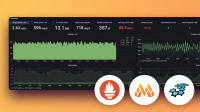Important: This documentation is about an older version. It's relevant only to the release noted, many of the features and functions have been updated or replaced. Please view the current version.
Grafana Mimir query-tee
The query-tee is a standalone tool that you can use for testing purposes when comparing the query results and performances of two Grafana Mimir clusters. The two Mimir clusters compared by the query-tee must ingest the same series and samples.
The query-tee exposes Prometheus-compatible read API endpoints and acts as a proxy. When the query-tee receives a request, it performs the same request against the two backend Grafana Mimir clusters and tracks the response time of each backend, and compares the query results.
Download the query-tee
- Using Docker:
docker pull "grafana/query-tee:latest"- Using a local binary:
Download the appropriate release asset for your operating system and architecture and make it executable.
For Linux with the AMD64 architecture, execute the following command:
curl -Lo query-tee https://github.com/grafana/mimir/releases/latest/download/query-tee-linux-amd64
chmod +x query-teeConfigure the query-tee
The query-tee requires the endpoints of the backend Grafana Mimir clusters.
You can configure the backend endpoints by setting the -backend.endpoints flag to a comma-separated list of HTTP or HTTPS URLs.
For each incoming request, the query-tee clones the request and sends it to each configured backend.
Note: You can configure the query-tee proxy listening port via the
-server.service-portflag.
How the query-tee works
This section describes how the query-tee tool works.
API endpoints
The following Prometheus API endpoints are supported by query-tee:
GET <prefix>/api/v1/queryGET <prefix>/api/v1/query_rangeGET <prefix>/api/v1/query_exemplarsGET <prefix>/api/v1/labelsGET <prefix>/api/v1/label/{name}/valuesGET <prefix>/api/v1/seriesGET <prefix>/api/v1/metadataGET <prefix>/api/v1/alertsGET <prefix>/prometheus/config/v1/rules
You can configure the <prefix> by setting the -server.path-prefix flag, which defaults to an empty string.
Pass-through requests
The query-tee can optionally act as a transparent proxy for requests to routes not matching any of the supported API endpoints.
You can enable the pass-through support setting -proxy.passthrough-non-registered-routes=true and configuring a preferred backend using the -backend.preferred flag.
When pass-through is enabled, a request for an unsupported API endpoint is transparently proxied to the configured preferred backend.
Authentication
The query-tee supports HTTP basic authentication. The query-tee can merge the HTTP basic authentication in the received request with the username and configured in a backend URL.
A request sent from the query-tee to a backend includes HTTP basic authentication when one of the following conditions is met:
- If the backend endpoint URL is configured with both a username and password, then query-tee uses it.
- If the backend endpoint URL is configured only with a username, then query-tee keeps the configured username and injects the password received in the incoming request.
- If the backend endpoint URL is configured without a username and password, then query-tee forwards the authentication credentials found in the incoming request.
Backend response selection
The query-tee enables you to configure a preferred backend that selects the response to send back to the client.
The preferred backend can be configured via -backend.preferred=<hostname>.
The value of the preferred backend configuration option must be the hostname of one of the configured backends.
When a preferred backend is configured, the query-tee uses the following algorithm to select the backend response to send back to the client:
- If the preferred backend response status code is 2xx or 4xx, the query-tee selects the response from the preferred backend.
- If at least one backend response status code is 2xx or 4xx, the query-tee selects the first received response whose status code is 2xx or 4xx.
- If no backend response status code is 2xx or 4xx, the query-tee selects the first received response regardless of the status code.
When a preferred backend is not configured, the query-tee uses the following algorithm to select the backend response to send back to the client:
- If at least one backend response status code is 2xx or 4xx, the query-tee selects the first received response whose status code is 2xx or 4xx.
- If no backend response status code is 2xx or 4xx, the query-tee selects the first received response regardless of the status code.
Note: The query-tee considers a 4xx response as a valid response to select because a 4xx status code generally means the error is caused by an invalid request and not due to a server side issue.
Backend results comparison
The query-tee can optionally compare the query results received by two backends.
The query results comparison can be enabled setting the flag -proxy.compare-responses=true and requires that:
- Two backends have been configured setting
-backend.endpoints. - A preferred backend is configured setting
-backend.preferred.
When the query results comparison is enabled, the query-tee compares the response received from the two configured backends and logs a message for each query whose results don’t match. Query-tee keeps track of the number of successful and failed comparison through the metric cortex_querytee_responses_compared_total.
Note: Floating point sample values are compared with a tolerance that can be configured via
-proxy.value-comparison-tolerance. The configured tolerance prevents false positives due to differences in floating point values rounding introduced by the non-deterministic series ordering within the Prometheus PromQL engine.
Exported metrics
The query-tee exposes the following Prometheus metrics at the /metrics endpoint listening on the port configured via the flag -server.metrics-port:
# HELP cortex_querytee_request_duration_seconds Time (in seconds) spent serving HTTP requests.
# TYPE cortex_querytee_request_duration_seconds histogram
cortex_querytee_request_duration_seconds_bucket{backend="<hostname>",method="<method>",route="<route>",status_code="<status>",le="<bucket>"}
cortex_querytee_request_duration_seconds_sum{backend="<hostname>",method="<method>",route="<route>",status_code="<status>"}
cortex_querytee_request_duration_seconds_count{backend="<hostname>",method="<method>",route="<route>",status_code="<status>"}
# HELP cortex_querytee_responses_total Total number of responses sent back to the client by the selected backend.
# TYPE cortex_querytee_responses_total counter
cortex_querytee_responses_total{backend="<hostname>",method="<method>",route="<route>"}
# HELP cortex_querytee_responses_compared_total Total number of responses compared per route name by result.
# TYPE cortex_querytee_responses_compared_total counter
cortex_querytee_responses_compared_total{route="<route>",result="<success|fail>"}


